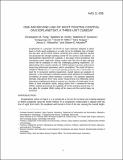One-arcsecond line-of-sight pointing control on exoplanetsat, a three-unit CubeSat
Author(s)
Pong, Christopher Masaru; Smith, Matthew William; Knutson, Matthew W.; Lim, Sungyung; Seager, Sara; Villasenor, Jesus Noel Samonte; Murphy, Shawn D.; Miller, David W; ... Show more Show less
DownloadMiller_One-arcsecond.pdf (1.340Mb)
OPEN_ACCESS_POLICY
Open Access Policy
Creative Commons Attribution-Noncommercial-Share Alike
Terms of use
Metadata
Show full item recordAbstract
ExoplanetSat is a proposed 10×10×34-cm space telescope designed to detect down to Earth-sized exoplanets in an orbit out to the habitable zone of bright, Sun-like stars via the transit method. Achieving this science objective requires one-arcsecond line-of-sight pointing control for the science CCD detector, an unprecedented requirement for CubeSats. A two-stage control architecture that coordinates coarse rigid-body attitude control with fine line-of-sight pointing control will be employed to meet this challenging pointing requirement. Detailed testing of the reaction wheels and CMOS detectors has been performed to extract key performance parameters used in simulations. The results of these simulations indicate that a 1.4 arcsecond pointing precision (3σ) is achievable. To meet the 1.0-arcsecond pointing requirement, several options are analyzed. In particular, a new technique to estimate reaction wheel vibrations for feed forward cancellation of reaction wheel vibrations is presented. This estimator adaptively estimates disturbances from noisy sensor measurements and effectively stores disturbance amplitude and phase in memory as a function of wheel speed. In addition to these simulation results, testing results from a hardware-in-the-loop (HWIL) testbed demonstrate the capability of the fine pointing control loop. Future plans for complete HWIL testing of the coarse and fine control loops are presented.
Date issued
2011Department
Charles Stark Draper Laboratory; Massachusetts Institute of Technology. Department of Aeronautics and Astronautics; Massachusetts Institute of Technology. Department of Earth, Atmospheric, and Planetary Sciences; Massachusetts Institute of Technology. Space Systems Laboratory; MIT Kavli Institute for Astrophysics and Space ResearchJournal
Advances in the Astronautical Sciences
Publisher
Univelt, Inc.
Citation
Pong, Christopher M., Matthew W. Smith, Matthew W. Knutson, Sungyung Lim, David W. Miller, Sara Seager, Jesus S. Villaseñor and Shawn D. Murphy. "One-Arcsecond Line-of-Sight Pointing Control on ExoplanetSat, A Three-Unit CubeSat." Advancements in the Astronautical Sciences, v.141 (2011) 20p.
Version: Author's final manuscript
Other identifiers
AAS 11-035
ISSN
0065-3438